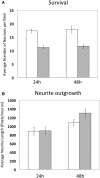Highly efficient method for gene delivery into mouse dorsal root ganglia neurons
- PMID: 25698920
- PMCID: PMC4313362
- DOI: 10.3389/fnmol.2015.00002
Highly efficient method for gene delivery into mouse dorsal root ganglia neurons
Erratum in
-
Erratum on: Highly efficient method for gene delivery into mouse dorsal root ganglia neurons.Front Mol Neurosci. 2015 May 18;8:16. doi: 10.3389/fnmol.2015.00016. eCollection 2015. Front Mol Neurosci. 2015. PMID: 26041989 Free PMC article.
Abstract
The development of gene transfection technologies has greatly advanced our understanding of life sciences. While use of viral vectors has clear efficacy, it requires specific expertise and biological containment conditions. Electroporation has become an effective and commonly used method for introducing DNA into neurons and in intact brain tissue. The present study describes the use of the Neon® electroporation system to transfect genes into dorsal root ganglia neurons isolated from embryonic mouse Day 13.5-16. This cell type has been particularly recalcitrant and refractory to physical or chemical methods for introduction of DNA. By optimizing the culture condition and parameters including voltage and duration for this specific electroporation system, high efficiency (60-80%) and low toxicity (>60% survival) were achieved with robust differentiation in response to Nerve growth factor (NGF). Moreover, 3-50 times fewer cells are needed (6 × 10(4)) compared with other traditional electroporation methods. This approach underlines the efficacy of this type of electroporation, particularly when only limited amount of cells can be obtained, and is expected to greatly facilitate the study of gene function in dorsal root ganglia neuron cultures.
Keywords: EGFP expression; Nerve growth factor (NGF); dorsal root ganglion (DRG) neuron; electroporation; gene expression; nucleofection; primary neurons; transfection.
Figures




Similar articles
-
Erratum on: Highly efficient method for gene delivery into mouse dorsal root ganglia neurons.Front Mol Neurosci. 2015 May 18;8:16. doi: 10.3389/fnmol.2015.00016. eCollection 2015. Front Mol Neurosci. 2015. PMID: 26041989 Free PMC article.
-
A simple and fast method to image calcium activity of neurons from intact dorsal root ganglia using fluorescent chemical Ca2+ indicators.Mol Pain. 2017 Jan-Dec;13:1744806917748051. doi: 10.1177/1744806917748051. Epub 2017 Dec 6. Mol Pain. 2017. PMID: 29212403 Free PMC article.
-
Role of neurotrophin signalling in the differentiation of neurons from dorsal root ganglia and sympathetic ganglia.Cell Tissue Res. 2009 Jun;336(3):349-84. doi: 10.1007/s00441-009-0784-z. Epub 2009 Apr 23. Cell Tissue Res. 2009. PMID: 19387688 Review.
-
Effective gene delivery to adult neurons by a modified form of electroporation.J Neurosci Methods. 2005 Mar 15;142(1):137-43. doi: 10.1016/j.jneumeth.2004.08.012. J Neurosci Methods. 2005. PMID: 15652627
-
Herpes simplex virus mediated nerve growth factor expression in bladder and afferent neurons: potential treatment for diabetic bladder dysfunction.J Urol. 2001 May;165(5):1748-54. J Urol. 2001. PMID: 11342969
Cited by
-
Light-Inducible Activation of TrkA for Probing Chronic Pain in Mice.ACS Chem Biol. 2024 Jul 19;19(7):1626-1637. doi: 10.1021/acschembio.4c00300. Epub 2024 Jun 18. ACS Chem Biol. 2024. PMID: 39026469 Free PMC article.
-
Nerve Growth Factor Signaling from Membrane Microdomains to the Nucleus: Differential Regulation by Caveolins.Int J Mol Sci. 2017 Mar 24;18(4):693. doi: 10.3390/ijms18040693. Int J Mol Sci. 2017. PMID: 28338624 Free PMC article.
-
Effect of Experimental Electrical and Biological Parameters on Gene Transfer by Electroporation: A Systematic Review and Meta-Analysis.Pharmaceutics. 2022 Dec 2;14(12):2700. doi: 10.3390/pharmaceutics14122700. Pharmaceutics. 2022. PMID: 36559197 Free PMC article. Review.
References
-
- Butcher A. J., Torrecilla I., Young K. W., Kong K. C., Mistry S. C., Bottrill A. R., et al. . (2009). N-methyl-D-aspartate receptors mediate the phosphorylation and desensitization of muscarinic receptors in cerebellar granule neurons. J. Biol. Chem. 284, 17147–17156. 10.1074/jbc.M901031200 - DOI - PMC - PubMed
LinkOut - more resources
Full Text Sources
Other Literature Sources
Research Materials

